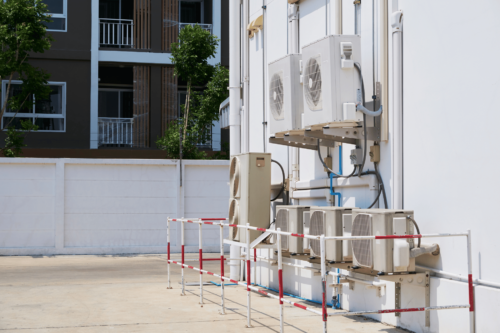
Work by E3 and others clearly indicates that electrification will be the primary strategy to decarbonize the building heating sector. This finding has held true in studies ranging from California’s moderate climate to Minnesota’s cold winters. However, complete or full building electrification poses several challenges, including the potential for significant increases in electric peak demands, high upfront costs for building retrofits, and increased utility bills for customers currently served by natural gas. One potential solution to these challenges is hybrid electrification.
Hybrid electrification, sometimes also called “partial” or “dual-fuel” electrification, essentially uses air-source heat pumps in existing buildings paired with combustion-based backup equipment. E3 experts Jared Landsman and Mike Sontag had the opportunity to present a survey of our research on the topic of hybrid electrification, including both its advantages and disadvantages, at the ACEEE Hot Air and Hot Water Forum in Atlanta, GA and the Getting to Zero Forum in Charlotte, NC.
Is hybrid electrification a “bridge to nowhere” as we push to decarbonize our energy economy as quickly as possible, or can it reduce emissions more quickly and more cost-effectively, and help pave the way for a zero-carbon future? E3’s analysis has shown the latter. Hybrid electrification has several potential advantages, including:

- Reduced greenhouse gas emissions compared to status quo systems.
- Reduced electric peak capacity requirements compared to all-electric systems, which tend to operate at relatively low efficiency at lower temperatures (Figure 1).
- Less expensive and less complex installations for certain buildings relative to all-electric systems. This is particularly true for older buildings in cold climates, residential buildings that would require a panel or service upgrade to accommodate all-electric heating, and for large commercial buildings that use a boiler for heating.
- Accelerated heat pump deployment via the air conditioning market, as customers may choose to install a heat pump not just as a replacement for heating equipment but for aging AC units as well. This would allow them to keep their existing gas heating system, but still adopt a heat pump.
- In many cases, hybrid systems can be cheaper to operate than all-electric systems, especially in regions with lower cost existing heating fuels and high electric demand charges.
- Reduced GHG emissions during peak heating hours relative to all-electric systems, which are served by more carbon intensive gas peaker plants particularly during very cold weather or in cases where a heat pump leverages electric resistance backup heat.
- Increased reliability from backup heating equipment during power outages. Although a gas furnace does require an electric blower fan, it is much simpler to power a fan with a back-up battery or generator than to power the heat pump for an entire home.
Hybrid electrification does, however, come with disadvantages, including:

- The emissions savings from hybrid systems could be limited if temperature switchover points are set too high and the switch from electric to back-up fossil heating occurs too soon, when outdoor temperatures are too warm (Figure 2). Addressing this issue and choosing the optimal switchover temperature will require careful consideration of electric and gas rate design, utility program design, installer education, and interoperability between heating equipment and thermostats.
- In the long run, the backup systems in hybrid electrification may rely heavily on low carbon fuels like renewable natural gas (RNG) or biodiesel. The feasibility and costs associated with producing these fuels at scale are still speculative. The highest value and best use of decarbonized fuels in a deeply decarbonized economy is likely to be hard-to-electrify sectors and end uses, so competition for these fuels from other sectors, such as aviation, is to be expected.
Whether the advantages or disadvantages of hybrid electrification predominate depends on the context and, perhaps, timing. For example, full electrification has been widely shown to be the most cost-effective solution in warm climates and for new construction. All-electric solutions may also be a preferred solution in circumstances where investments in natural gas infrastructure can be cost-effectively avoided via targeted electrification. On the other hand, hybrid electrification will likely have an important role over the near- to medium-term in very cold climates, in locations where the local gas infrastructure is not a good target for cost-effective decommissioning, and in the challenging-to-electrify segments of the built environment noted above. The longer-term balance between hybrid vs all-electric systems is still an open question, but the answer will likely depend on climate and building type, as well as the cost and availability of decarbonized fuels. Across all climates and use cases, however, advanced rate structures and other policies will be important to ensure that systems are operated in an optimal manner for customers, the environment, and the grid.
Electrification in all its forms comes with real challenges, and the optimal long-term pathway to achieve a largely electrified building stock remains uncertain. Hybrid heating represents an opportunity to kickstart heat pump adoption and manage the system impacts of electrification. To not pursue hybrid electrification today could mean to risk missing significant near-term system-level benefits and sector-wide emissions reductions.
Look out for upcoming E3 presentations on the benefits and challenges of hybrid electrification at the ACEEE Summer Study on Energy Efficiency in Buildings in Pacific Grove, CA in August, or catch up on E3’s presentation slides here.


